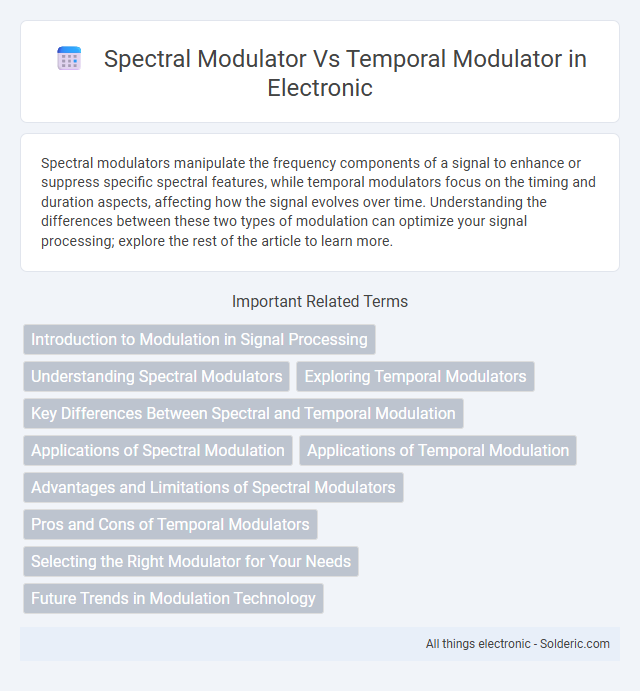Spectral modulators manipulate the frequency components of a signal to enhance or suppress specific spectral features, while temporal modulators focus on the timing and duration aspects, affecting how the signal evolves over time. Understanding the differences between these two types of modulation can optimize your signal processing; explore the rest of the article to learn more.
Comparison Table
| Feature | Spectral Modulator | Temporal Modulator |
|---|---|---|
| Definition | Modulates the frequency components (spectrum) of a signal. | Modulates the timing or phase of signal components over time. |
| Modulation Domain | Frequency/Spectral domain | Time/Temporal domain |
| Primary Function | Alters or analyzes spectral content for filtering or enhancement. | Controls signal changes over time such as rate or rhythm. |
| Common Applications | Audio equalizers, speech coding, spectral shaping | Speech rhythm processing, temporal pattern recognition, envelope detection |
| Example Signal Effect | Emphasizes or suppresses specific frequencies. | Changes amplitude or phase variation over time. |
| Analysis Tools | Spectrum analyzers, Fourier transform | Oscilloscopes, autocorrelation, temporal envelope detection |
Introduction to Modulation in Signal Processing
Modulation in signal processing involves varying a carrier signal to encode information, with spectral modulators altering frequency components and temporal modulators changing the signal over time. Spectral modulators focus on frequency domain manipulation, optimizing bandwidth and reducing interference for clearer communication channels. Your understanding of modulation techniques is essential for designing efficient systems that handle diverse signal environments effectively.
Understanding Spectral Modulators
Spectral modulators manipulate the frequency components of a signal to enhance or suppress specific spectral features, crucial in audio processing and telecommunications. Unlike temporal modulators that modify the signal in the time domain, spectral modulators operate in the frequency domain, offering precise control over bandwidth and harmonics. Your ability to understand spectral modulation improves signal clarity and performance in applications like speech recognition and noise reduction.
Exploring Temporal Modulators
Temporal modulators manipulate sound by altering its amplitude, frequency, or phase over time, enabling dynamic audio effects such as tremolo and vibrato. These modulators differ from spectral modulators, which target frequency components to shape the sound's tonal content. Exploring temporal modulators reveals their capacity to create rhythmic patterns and evolving textures essential for sound design and music production.
Key Differences Between Spectral and Temporal Modulation
Spectral modulation involves changes in the frequency or amplitude across different frequencies at a single point in time, while temporal modulation refers to variations over time in a specific frequency or overall signal amplitude. Key differences include spectral modulation's focus on frequency domain characteristics and temporal modulation's emphasis on time domain fluctuations. Understanding these distinctions helps you analyze signal processing techniques more effectively in audio and communication systems.
Applications of Spectral Modulation
Spectral modulation plays a crucial role in audio signal processing, especially in applications such as speech synthesis, hearing aid design, and music production by manipulating the frequency components of sounds for clearer and more natural output. It enhances spectral contrast and improves speech intelligibility in noisy environments, making it essential for advanced auditory prosthetics and automatic speech recognition systems. Unlike temporal modulation, which deals with timing and rhythm, spectral modulation specifically targets frequency domain features for refined sound quality and perceptual enhancement.
Applications of Temporal Modulation
Temporal modulation plays a critical role in auditory processing, speech recognition, and music perception by encoding changes in sound intensity over time. Your auditory system relies heavily on temporal modulation for detecting rhythm, pitch variation, and speech syllable boundaries, which are essential for effective communication and language comprehension. Temporal modulation is also crucial in neurophysiological research and the development of advanced hearing aids and cochlear implants that aim to improve temporal resolution and sound quality.
Advantages and Limitations of Spectral Modulators
Spectral modulators offer precise wavelength control, enabling high-resolution signal processing and enhanced channel capacity in optical communication systems, making them ideal for applications requiring fine spectral filtering. Their ability to manipulate specific frequency components allows for reduced crosstalk and improved signal-to-noise ratio compared to temporal modulators. However, spectral modulators often face limitations such as complexity in design, higher cost, and sensitivity to environmental fluctuations, which may challenge stability and scalability in practical implementations.
Pros and Cons of Temporal Modulators
Temporal modulators offer precise control over signal timing and phase, enhancing synchronization in communication systems and improving temporal resolution in imaging applications. However, they can introduce complexity in system design due to their sensitivity to timing jitter and require advanced electronics for accurate modulation and demodulation. Your choice between temporal and spectral modulators should consider the trade-off between temporal fidelity and system complexity based on the application's specific needs.
Selecting the Right Modulator for Your Needs
Selecting the right modulator involves understanding the key differences between spectral and temporal modulators. Spectral modulators control the intensity or phase of light across different wavelengths, ideal for applications requiring precise frequency shaping such as spectroscopy or communications. Temporal modulators manipulate the time properties of light pulses, making them suitable for ultrafast optics or time-resolved measurements tailored to your specific technical requirements.
Future Trends in Modulation Technology
Future trends in modulation technology emphasize the integration of spectral and temporal modulators to enhance data transmission speeds and signal integrity in 6G networks. Advances in machine learning algorithms are driving adaptive spectral modulators that optimize frequency allocation in real-time, while temporal modulators are evolving to support ultra-low latency communication in edge computing environments. Innovations in photonic and quantum modulation techniques promise to revolutionize both spectral and temporal domains, enabling unprecedented bandwidth and processing capabilities.
Spectral modulator vs temporal modulator Infographic

 solderic.com
solderic.com